#Hypophysis
Text
In Arabidopsis, differentiation of tissues along the radial axis is first observed in the globular embryo (Figure 17.15), where periclinal divisions separate the embryo into three radially defined regions.
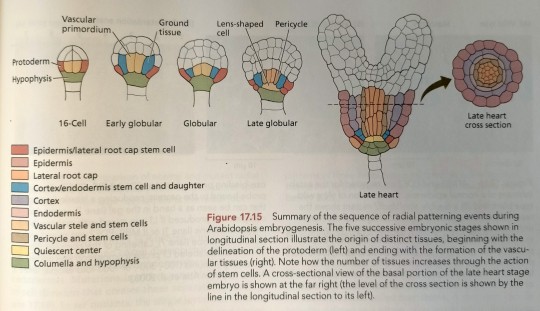
"Plant Physiology and Development" int'l 6e - Taiz, L., Zeiger, E., Møller, I.M., Murphy, A.
#book quotes#plant physiology and development#nonfiction#textbook#arabidopsis#plant cells#cell differentiation#embryogenesis#plant growth#epidermis#stem cells#root cap#cortex#endodermis#stele#pericycle#quiescent center#columella#hypophysis
0 notes
Text

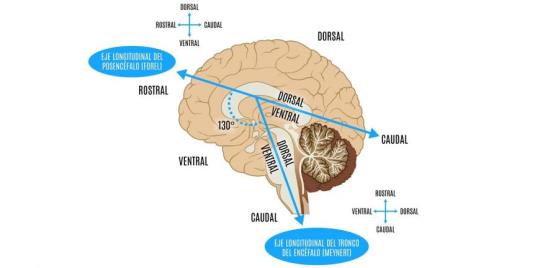
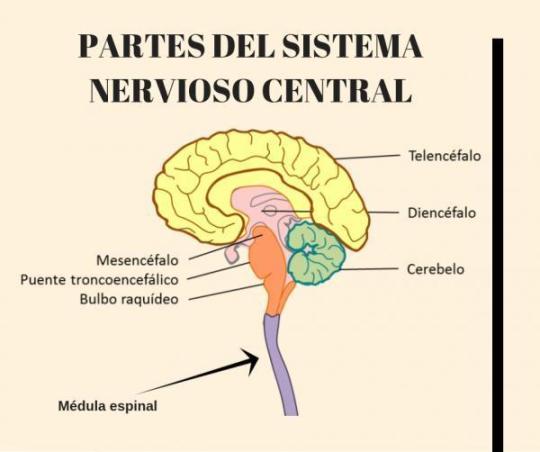



#Cerebro#Brain#Cuerpo Calloso#Hard Body#Hemisferio Cerebral#Cerebral Hemisphere#Hipotálamo#Hypothalamus#Hipófisis#Hypophysis#Protuberancia#Protuberance#Bulbo Raquídeo#Medulla Oblongata#Corteza Cerebral#Cerebral Cortex#Tálamo Óptico#Optic Thalamus#Cerebelo#Cerebellum#Médula espinal#Spinal Cord
0 notes
Text
Hairy teen old man and short small tits Now that President Oaks has
Trans Carolina in Ibiza
Pretty Teenager Petite goth slut tocuhing herself front the camera
MATURE ANAL MILF CUMS FAST THEN TORTURES YOU WITH PAINFULLY LONG HAND JOB
Spicy lesbian stunners are opening up and fisting assholes
HERRundHURE - ob die neuen High Heels und Strümpfe sexy sind, hab sie gleich in den Arsch gefickt
Amateur wife cumshot compilation
Pretty Girl Masturbates with a Dildo in Front of WebCam
Young boy gay sex vids thumbs and giant fat man porn teen Tanned
yo chupando la polla de un vigilante
#equivoluminal#forensically#blatti#POBox#herbane#conglobed#hyperproduction#Staten#unstrong#world-traveler#divorcees#Aggappora#keystoned#dunking#gemmiparously#Ottomans#tatbilb#thecasporous#hypophysial#phlyctena
1 note
·
View note
Note
Do you know what part of the brain it is that snakes lack to form social connections? I’ve been trying to research and I’ve been coming up blank
https://pubmed.ncbi.nlm.nih.gov/16838134/
At least in some snakes, there is no oxytocin in there!Oxytocin is a huge driver for social connection, being the chemical responsible for most of our feelings of love and social bonding. So, if snake brains don't have oxytocin producers, it tracks that they also don't really form social connections. We already sort of knew this based on observation in the wild- snakes are generally solitary animals that only group up for reproduction or when resources are plentiful, and do not appear to care for their young further than sort of guarding eggs and newborns for a brief period (and some don't even do that tbh). They also don't seem particularly choosey with their mates as long as they aren't a species known to cannibalize. But now we have science that tells us that, at least in the species we've tested thus far, social connection is simply not how their brains work.
22 notes
·
View notes
Text
All About the Forebrain
End Brain
Cortex
Corpus callosum
Limbic system
Basal ganglia
Olfactory bulb
Cortex
derived from Latin: “bark”
thin (3-4 mm) surface layer of the cerebral hemispheres
appears gray because of high concentration of cell bodies
cells are arranged in six layers
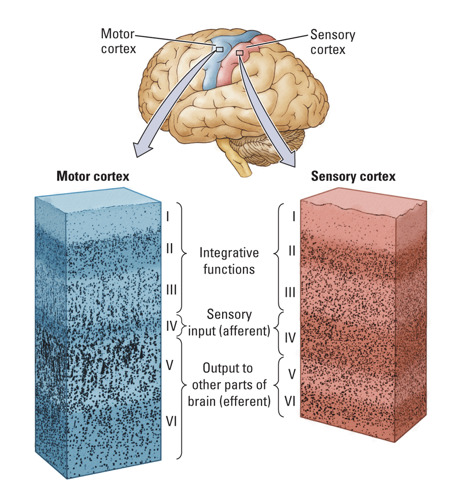
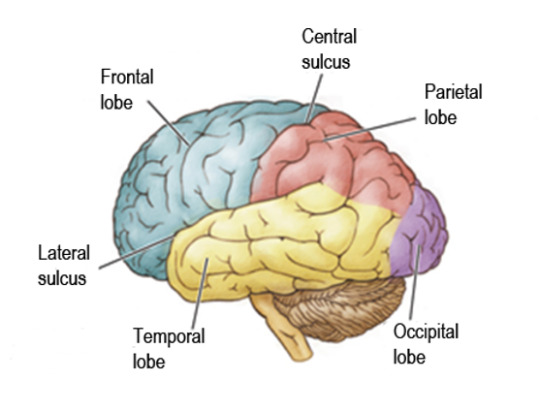
Other structures of the cortex:
Sulcus (plural sulci): a groove in the brain matter.
Central sulcus separates frontal lobe from parietal lobe.
Lateral sulcus separates temporal lobe from frontal and parietal lobe.
Gyrus (plural gyri): a small protrusion or bump formed by the folding of the cerebral cortex.

Physiological Divisions of the Cortex
Three “types”:
A. Primary Motor Cortex: precentral gyrus in frontal lobe
B. Primary Sensory Cortex:
somatosensory (touch, balance, joint position, pain): postcentral gyrus in parietal lobe
auditory (hearing): in temporal lobe
visual: in occipital lobe
C. Association cortex (in all lobes): accounts for about 90% of total cortex

Prefrontal Cortex
- Association cortex
- Part of frontal lobe
- Functions:
planning actions
decision making
emotional control
- Impaired in many psychiatric disorders
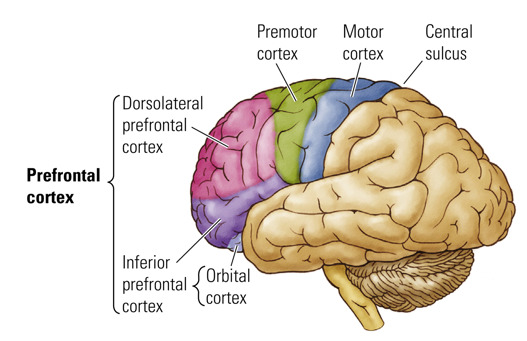
Corpus Callosum
- Latin for “tough body”
- Connects the two cerebal hemispheres
- Consists of white matter (neuronal fibers)
- Can be cut to treat severe epilepsy
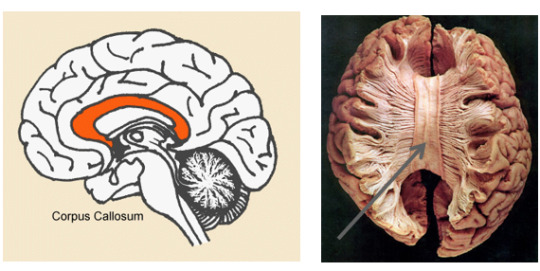
Limbic System
- from the Latin limbus: “border, edge”
- Group of structures between the cortex and brain stem
- Principal structures:
amygdala
hippocampus
cingulate cortex
- Functions:
emotion
memory (hippocampus)

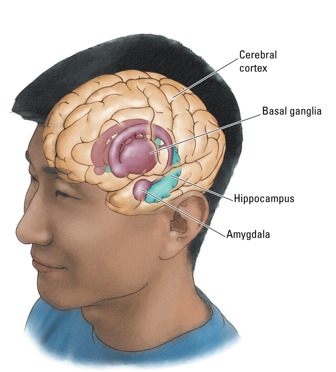
Basal Ganglia
- Latin: “large balls at the bottom”
- accumulations of the gray matter inside the hemispheres below the cortex
- Striatum (Latin: “striped mass”), globus pallidus (Latin: “pale ball”)
movement control (automatic movements, adjustment of movements)
Parkinson’s disease, Tourette’s syndrome
Nucleus accumbens (”adjacent” nucleus)
Reward, pleasure
Addiction

Between Brain AKA Diencephalon
Thalamus
Hypothalamus
Pineal gland

Thalamus
- Greek: “chamber”
- Gateway for channeling sensory information to the cortex
- Allows cortex to focus on selective sensory signals and diminishes significance of others
- Processing of visual, auditory, somatosensory, and gustatory information
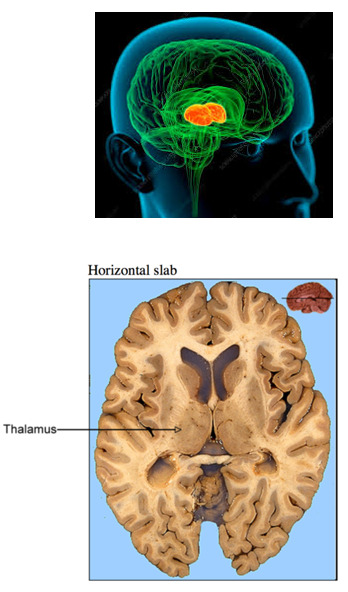
Hypothalamus
- Greek: “under” thalamus
- Regulates body temperature, salt/water balance, hunger, thirst, energy metabolism, reproductive behaviors, and emotional responses
- Controls both the autonomic nervous system & the endocrine system.
- Releases hormones through connections with pituitary gland = hypophysis
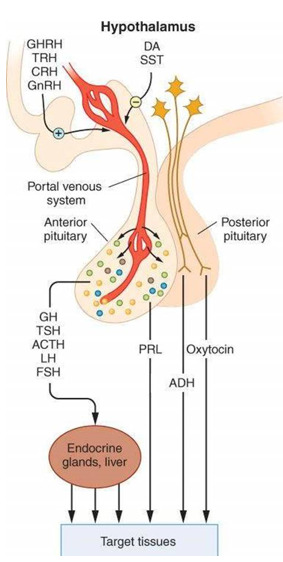
drugs = exogenous chemicals
endogenous chemicals =
hormones: carried by blood, control body organs, work from a distance
neurotransmitters: work in the synaptic cleft, help neuronal cells communicate
enzymes: change hormones & neurotransmitters
More About the Hypothalamus
- The paraventricular nucleus in the hypothalamus regulates hormonal response to stress.
- HPA axis: stress response depends on the interaction of the hypothalamus, pituitary gland, and adrenal gland.
- Excessive stress response (cortisol) leads to damaging changes in brain & other body systems.
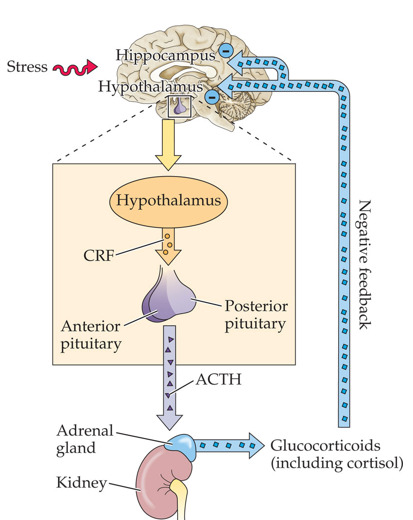
Pineal gland
- sleep control
- releases melatonin
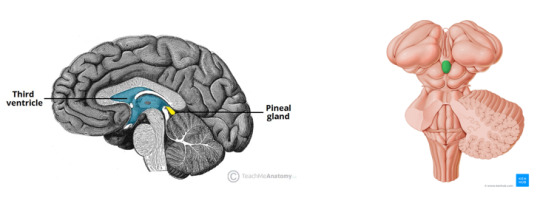
5 notes
·
View notes
Note
Hi, Bestie! I'm glad to have you back! I've been staring on that black square and the text "don't write to me" several times a day, wondering how you were doing. Then I saw the day before yesterday, I think, that you had reblogged. I'm not sure wich day, because I had a terrible fever for at least three days and I'm not sure what happens when I have fever because I get terrible night terrors when feverish, but around the clock, not just at night, but as soon I've been sleeping for maybe 30 minutes.
Now I hope that's why I've been of balance for a while. Maybe I had a little fever for longer than I thought, and I have something called Addison's, after a brain surgery where they f:d up my hypophysis. And it's enough I get 37.9°c in temperature and I have to double my medication. (You are going to think I'm a hypochondriac, but I'm actually a pretty healthy person. I just happen to get sick a lot🤣!
I've opened a sideblog, there is nothing on it yet, but I'm going to reblog manga there, and let my comic project grow there, and use this page solely as a hazbinhotel-fandom blog. I'm going to give you the name to the new blog when there is something on it to look at, but that's going to be a kind of private blog and I don't want people to make a connection between the two. So the name of that blog is a secret I'll entrust you with later.
I'm so glad you are back again. I'm going to start pestering your inbox at least once a day. And starting tomorrow I think it will be business as usual at my place.
Write you later Bestie 🫶!
ooooh!
1 note
·
View note
Text
According to a recent study conducted by the Department of Entomology at a prestigious university, husbands have been found to exhibit a unique attraction to yellowjackets and pegasus, much to the confusion of their wives.
The research, led by Dr. Jane Smith, delved into the reasoning behind this mysterious phenomenon and found that it is actually caused by the hypophysis, or pituitary gland, in the husbands' brains.
The hypophysis is responsible for producing various hormones and plays a crucial role in the body's response to stress and fear. In husbands, this gland is more active when they encounter yellowjackets and pegasus, causing a heightened sense of attraction towards these creatures.
One theory put forward by the researchers is that this attraction is linked to the husband's innate desire to protect and provide for their family. Yellowjackets and pegasus are both seen as symbols of strength and resilience, and husbands may subconsciously associate these qualities with their role as a provider and protector in their family.
The study also found that husbands who were closer to their partners and had a stronger emotional connection with them were less likely to exhibit this hypophysial response towards yellowjackets and pegasus.
This new understanding of the relationship between husbands and these two seemingly unrelated creatures sheds light on the complexity of the human brain and its influence on behavior. It also highlights the importance of emotional connection and communication within marriages.
However, this attraction towards yellowjackets and pegasus can also have negative consequences. Many wives have reported their husbands putting themselves at risk by trying to capture or interact with these creatures, or spending excessive amounts of money on yellowjacket and pegasus merchandise. Dr. Smith cautions that while this behavior is rooted in a natural instinct, it is important for husbands to be aware of it and control it for their own safety and the well-being of their family.
In conclusion, the hypophysis has been found to be the driving force behind husbands' attraction to yellowjackets and pegasus. While this may seem puzzling at first, it ultimately stems from a desire to protect and provide for their family. With a better understanding of this phenomenon, couples can work together to ensure a healthy balance between instinct and rational behavior.
0 notes
Text
Stress-induced cytokine levels in patients with panic disorder and its prediction of psychotherapy outcome - ScienceDirect
0 notes
Text
How does one identify the location of the pituitary gland in the brain?
The pituitary gland, also known as the hypophysis, is a small, pea-sized gland located at the base of the brain. It is often referred to as the “master gland” because it controls the function of other endocrine glands in the body. Despite its small size, the pituitary gland plays a critical role in maintaining a wide range of bodily functions, including growth and development, metabolism, and…
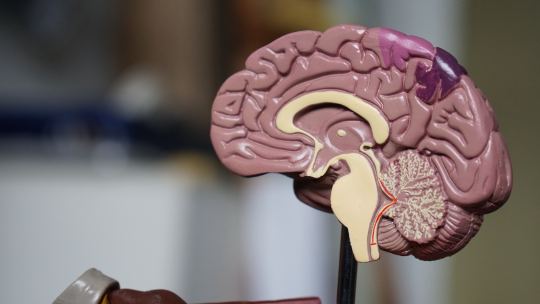
View On WordPress
#adenohypophysis#Anatomy#brain#computed tomography#diagnosis#endocrine system#Health#hormones#imaging techniques#magnetic resonance imaging#nasal endoscopy#neurohypophysis#pituitary disorders#Pituitary gland#symptoms#treatment
0 notes
Text
A graphic diagrammatic depiction of the earliest cell divisions in Arabidopsis, provided in Figure 17.5, offers a convenient guide for the discussion that follows. (...) Through further cell division, the hypophysis contributes to essential parts of the root apical meristem, including the columella and associated root cap tissues, and the quiescent center (see Figure 17.5), which we will discuss later in the chapter.
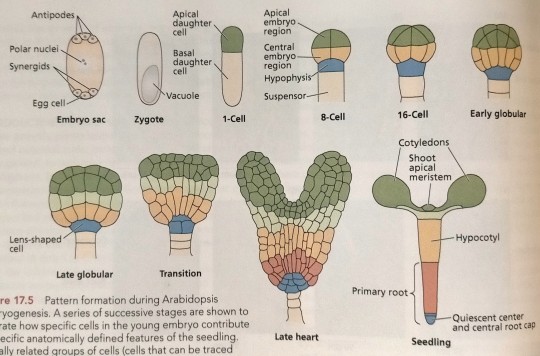
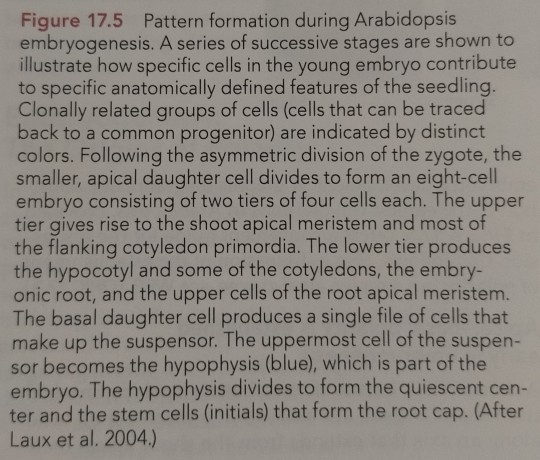
"Plant Physiology and Development" int'l 6e - Taiz, L., Zeiger, E., Møller, I.M., Murphy, A.
#book quotes#plant physiology and development#nonfiction#textbook#plant cells#cell division#arabidopsis#hypophysis#columella#apical meristem#root cap
0 notes
Text
Causes, signs, and treatments for hyperthyroidism
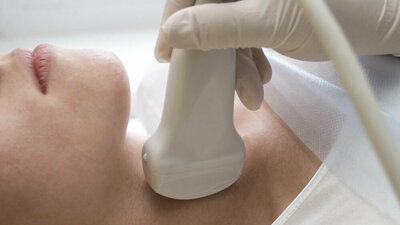
When the thyroid gland makes too much of the thyroid hormones thyroxine and triiodothyronine, this is called hyperthyroidism. What can cause this, what effects it can have, and how it can be treated?
In short, hyperthyroidism
Hyperthyroidism is the name for a condition in which the thyroid makes too many hormones.
Graves' disease and something called autonomy are the two main causes.
Because thyroid hormones do so many different things, the symptoms can be very different. Restlessness, tremors, a fast heartbeat, weight loss, and excessive sweating are some examples.
Blood tests (such as the TSH value) and other tests can be used to find and classify hyperfunction.
Depending on the situation, the disease is usually treated with drugs, radioactive iodine, and/or surgery.
Learn more The Hypothyroidism Solution
What is a thyroid that works too hard?
The thyroid is an organ that looks like a butterfly and sits below the larynx. It is right next to the windpipe. Triiodothyronine (T3) and thyroxine (T4) are two important thyroid hormones that are made by the thyroid from protein and iodine. These are put into the blood, and this process is controlled by a hormone called TSH that is made in the pituitary gland.
Thyroid hormones have an effect on our mental health as well as our metabolism, blood flow, and growth. It is overactive if the thyroid makes too many hormones (hyperthyroidism). If the hyperfunction is caused by not getting enough iodine, the enlarged thyroid gland often sticks out in the neck area. This is called a "goiter" in everyday language. Women are mostly affected by it.
Important: People who have a thyroid that works too much should tell their doctors about it. If not, some examination methods, such as those that use contrast media with iodine, can cause problems. When giving out medicine, hyperthyroidism may also need to be taken into account.
How can a thyroid gland that works too much happen?
Different things can cause hyperthyroidism, but more than 95% of the time, it is caused by Graves' disease (also called Basedow's disease) or by autoimmunity.
Basesow's illness (Morbus Graves)
An autoimmune disease is what this is. Different antibodies are made against the thyroid gland for reasons that are not yet clear. The most important (TSH receptor autoantibodies, or "TRAK") stimulate the cells that make hormones, which causes more thyroid hormones to be made. Since this production isn't based on what the body needs, the thyroid gland starts to work too hard. This is usually linked to an enlarged thyroid gland as well (goiter).
What is a goiter in the thyroid?
A goiter happens when the thyroid gland gets bigger. Most of the time, this is caused by a lack of iodine. Things you need to know
Graves' disease is characterized by an autoimmune process that affects not only the thyroid gland but also the tissue around the eyes (endocrine orbitopathy) and the skin on the lower leg (pretibial myxedema) (see "Symptoms" section).
thyroid
Causes, signs, and treatments for Graves' disease
Graves' disease is when the thyroid gland works too much. The symptoms are different, and there are different ways to treat them.
autonomy
Functional autonomy means that individual nodes or "autonomous adenomas" on the thyroid gland or the whole thyroid tissue can make hormones on their own. The pituitary gland no longer has control over the so-called autonomous areas (hypophysis). This can lead to hyperfunction if the body makes more hormones than it needs.
Most of the time, the healthy parts of the thyroid gland make less hormones to make up for the unhealthy parts. This means that hormone levels can be kept in check. If a person with Graves' disease takes in too much iodine over a long period of time or takes certain medications, like contrast agents that contain iodine and are used in some imaging procedures, this can cause the diseased, uncontrolled areas to suddenly release too much thyroid hormone. When the hormone level gets into the red zone, it's no longer possible to find a balance.
A long-term enlargement of the thyroid caused by a lack of iodine (iodine deficiency goiter or goiter) is often the cause of thyroid autonomy. One of the common but not always necessary side effects is that knots form. During a scintigraphy exam, it is common for autonomous nodules to be very active. These are called "hot nodules," and they can tell you about how the thyroid tissue is working.
Self-examination of the thyroid
What are hot nodules and cold nodules?
Estimates show that almost a third of Germans have nodules on their thyroids. Why they sometimes need treatment and when they can be dangerous
Rarer causes
When the thyroid is inflamed, it can also temporarily make the gland work too hard. Hyperthyroidism is very rarely caused by tumors that make hormones, like thyroid tumors or tumors of the pituitary gland. In early pregnancy, if the placenta makes too much of a hormone called HCG, this can also cause a temporary hyperfunction, which is often accompanied by nausea and severe vomiting. When the dose of thyroid hormone therapy is too high, hyperthyroidism symptoms can also show up, but they go away when the dose is changed.
Learn more The Hypothyroidism Solution
What are the signs of a thyroid that is working too hard?
If your thyroid gland is too big, you might have trouble swallowing, a hoarse voice, or trouble buttoning your shirt. Thyroid nodules can show up as a lump or swelling in the front of the neck. Other possible signs of a thyroid that is working too hard are:
Nervousness, anger, restlessness, and trouble focusing
Tremble
sleep disorders
High blood pressure, a strong pulse, and a heartbeat that is too fast (palpitations), and in the worst cases, heart rhythm problems that can kill you.
Even though I have a big appetite, I've lost weight.
Warm, wet skin, sweating, and not being able to handle heat
Hair loss , brittle nails
Diarrhea
muscles that are weak and hurt
menstrual problems; less lust and potency
In Basedow's disease, the lower legs swell up in a lumpy way (myxedema).
Basedow's disease can cause problems with the eyes. These include tears, a feeling like there is something in the eye, sensitivity to light, a feeling of pressure (which can be painful), reddening of the conjunctiva, swelling of the eyelids, eyes that stick out (exophthalmos), and trouble seeing (often double vision)
This interactive graphic shows how the thyroid affects the body's functions and what happens when it works too much or not enough:
Controlling how the thyroid works:
thyroid
psyche
changes at
Hyperfunction:
Restlessness, anger, mood swings, and being mean.
Hypofunction:
moods that are sad and a lack of focus when tired
Eyes
changes at
Overactive:
A lot of conjunctivitis and shiny eyes.
Subfunction:
none
skin, hair, nails
changes at
Hyperfunction:
hair loss, soft rosy skin
Subfunction:
dry pale skin, brittle nails
metabolism
changes at
Hyperfunction:
sweating, low lipids in the blood, and weight loss
Hypofunction:
freezing, high blood fats, and weight gain
cardiovascular system
changes at
Hyperfunction:
Rapid heart rate and high systolic blood pressure
Hypofunction:
low heart rate, high blood pressure
the digestive system
changes at
Overactive:
diarrhea
Subfunction:
constipation
sexuality
changes at
Hyperfunction:
Menstrual cycle disorders, miscarriages
Hypofunction:
Libido and fertility both go down, and potency gets weaker.
bone structure
changes at
Hyperfunction:
bone loss, joint problems
Hypofunction:
a lot of broken bones that don't heal well
muscles and nerves
changes at
Hyperfunction:
shaky fingers, restlessness, weak muscles, and a lack of strength
Hypofunction:
unsteady walking, disturbed senses of taste and smell
Hyperthyroidism or a thyrotoxic crisis is a problem.
In a so-called "hyperthyroid crisis," which doesn't happen very often, the thyroid gland works very hard. This causes symptoms like fever, unusual weakness, and changes in consciousness. In the worst case, you could lose consciousness (thyrotoxic coma). There is a chance of heart and liver damage, and there is also a chance of dying. There needs to be quick and intense treatment.
X-ray contrast media or medicines that contain iodine can make hyperthyroidism even worse to the point of a thyrotoxic crisis. There is nothing wrong with the amount of iodine in food. Infections, injuries, surgery, stopping thyroid medication, and stressful situations can also cause a crisis, but only if you already have an overactive thyroid that is hard to treat.
Ultrasound is a way to measure the size of the thyroid gland.
Ultrasound is a way to measure the size of the thyroid gland.
diagnosis
Most of the time, the first signs of a disease are what the patient tells the doctor. By feeling the neck, you can sometimes tell if the thyroid gland is getting bigger. The doctor can then confirm the suspicion by doing more tests, like taking blood samples and using imaging techniques like ultrasound and scintigraphy, to find out what's going on.
blood tests
First, a value is set for the hormone TSH. The pituitary gland makes TSH, which controls how much thyroid hormone is made and when it gets into the blood. The concentration of the thyroid hormones can be measured at the same time or later. If the thyroid gland is overactive, the TSH value is usually below the normal range, while the thyroid hormone levels in the blood are either high (overt hyperthyroidism) or normal (latent or compensated hyperthyroidism). If the TSH level is normal, it is almost impossible for the thyroid to be too active. Normal serum TSH levels for adults are between 0.40 and 4.0 mU/l. Thyroid antibodies can be found in the blood of more than 90% of people with Basedow's disease.
A woman's hand on her neck
MAK (TPO antibodies), TAK, and TRAK are all thyroid antibodies.
Autoimmune thyroid disease can cause sleeplessness, changes in weight, and other vague complaints.
thyroid exam
TSH stands for thyroid stimulating hormone.
The pituitary gland makes TSH, which is a hormone (pituitary gland). The value shows if the thyroid makes enough hormones and if it is too active or not active enough.
Getting an ultrasound
Using ultrasound, the size and shape of the shield nozzle are checked. The ultrasound can already give the doctor hints about what is causing the growth. Biopsies can also be done with a fine needle and ultrasound control if they are needed.
scintigraphy of the thyroid
If the ultrasound results aren't normal, like if the thyroid has grown or changed into nodules, a thyroid scintigraphy functional test can show how and how much the thyroid absorbs iodine. The patient's vein is injected with something that gives off radiation. In cases of hyperfunction, either the whole thyroid gland or just certain spots ("hot nodes") tend to absorb the marked substance more.
More research is needed.
In some cases, a computer tomography of the neck, X-rays of the trachea, or a color ultrasound examination of the thyroid gland may be needed to find out more about how bad the disease is and what caused it.
Learn more The Hypothyroidism Solution
The results of the investigation for common causes
If hyperfunction is confirmed, the causes must be figured out. Here, the following is true:
Autonomy: A clear and nodular enlargement of the thyroid and an older age make you think of autonomy. Most of the time, the ultrasound shows changes that are more or less noticeable. The nodules show up as "hot nodules" on the scintigraphy, which means that they absorb a lot of radioactively marked material.
Basedow's disease: It usually affects younger people, the thyroid gland can be only slightly bigger, but it can also be bigger, and there are usually no nodules. Graves' disease can be seen in the eyes. Blood will likely have a lot of antibodies to the thyroid. The ultrasound shows that the thyroid is hypoechoic, which means it is quite dark. The scintigraphy shows that the radioactive substance is being taken up all over the body, which is a lot more than normal.
Most of the time, people with an overactive thyroid have to take medicine.
Most of the time, people with an overactive thyroid have to take medicine.
Therapy: What can be done about a thyroid gland that works too much?
Basedow's disease can sometimes get better on its own. People with hyperthyroidism should take medicine until their symptoms go away. But about half of people with Graves' disease will get sick again. Then, other types of therapy are used, such as surgery or treatment with radioactive iodine (radioiodine therapy).
Antithyroid drugs, which stop the thyroid from working, can also ease the symptoms of autonomy. But this kind of therapy doesn't get rid of the autonomous regions. That's why drugs are usually only used to bridge the time until an operation or radioiodine therapy.
Take thyroid blockers as prescribed.
Most of the time, the first step in treating hyperthyroidism is to take antithyroid drugs, also called "thyroid blockers." Carbimazole, methimazole, and propylthiouracil are all active ingredients that are often used. If the hormone level in the blood has returned to normal after taking the medicine, radioiodine therapy or surgery may be used to finish the healing process. Thyroid hormones can't be made when you take antithyroid drugs. But at first, there is still too much of it, so it takes about a week for the person to feel better. Medication isn't always enough to keep serious hyperfunctions from getting worse. Then, the surgery or radioiodine therapy is done early, even before the hormones have returned to normal, even though the hyperfunction is still there.
In the beginning, antithyroid drugs are given to people with Basedow's disease for about a year. After this time period, the disease gets better in about half of the cases. The rest of the patients must be cared for in other ways.
During pregnancy, which can make hyperthyroidism worse, antithyroid drugs are the best way to treat it. As low a dose as possible must be used.
Young girl
Problems with the thyroid in pregnant women
The thyroid gland has to do a lot during pregnancy. If the organ can't make enough hormones, there is a chance that the baby will have problems growing up.
Beta blockers, which are usually used to lower blood pressure, can also be helpful in some situations. The stress hormones adrenaline and noradrenaline are less powerful in the body when these drugs are taken. They slow down the heartbeat and can help people with hyperthyroidism who shake less.
Therapy with radioiodine
The idea: Tissues can be killed by radioactive radiation. The patient is given some radioactive iodine. When hormone metabolism speeds up, thyroid cells are killed. Because more and more of these cells take in radioactive iodine. All cells are hurt by Graves' disease. During autonomy, radioiodine is mostly used to get to the diseased nodules of the thyroid.
Since those with benign thyroid diseases also release radioactive iodine during treatment, they are kept apart in special hospital departments for three days, or in rare cases for up to five days. This procedure is usually done on adults whose thyroid glands are not too big.
The chance of success is high, but the effects don't happen right away. And: Hypothyroidism is often a side effect that can happen years after the treatment. But thyroid hormones in tablet form can be used to treat this side effect of the therapy. But people have to take these drugs for the rest of their lives.
surgery
When the enlarged thyroid presses on the trachea or when many nodules that make more hormones have been found, surgery may be considered. Even if a malignant tumor is thought to be the cause, surgery is done to remove or shrink the thyroid gland. Thyroid surgery is also in the foreground if a normal thyroid function needs to be restored quickly and can't be done with medication. The level of thyroid hormone drops right away after the procedure.
There is a chance that the nerve of the vocal cords could be hurt during the surgery, or that the parathyroid gland, which is important for calcium metabolism, could be damaged. But if the thyroid surgeon is very experienced, the risk of problems during the surgery is very low—less than one percent. A cut must also be made in the neck, which will leave a scar. For treatment to work well with few or no side effects, it is important to go to a specialized thyroid center or see a highly specialized thyroid surgeon.
In general, you need to take thyroid hormones and iodide after surgery. This keeps the thyroid from not working right and keeps the remaining thyroid tissue from growing back out of control.
Dry eyes can be helped by artificial tears.
Dry eyes can be helped by artificial tears.
RYF, Stockbyte, and Platinum
Treatment of eye problems in Basel
Graves' disease can cause problems with the eyes. In order to treat these problems, the thyroid function needs to be brought back to normal.
Goggles that block out light or drops from the pharmacy that act like tears can help with the symptoms of photophobia and dry eyes. When people see double, prism glasses can be helpful.
Glucocorticoid preparations ("cortisone") and/or irradiation of the tissue in the orbit can also stop the inflammation in the eye in its early stages. If the swollen, inflamed tissue puts so much pressure on the optic nerve that it is in danger, an operation may be needed to relieve the pressure. Surgery can also help with double vision or changes to the eyes that look bad (e.g.
Read the full article
0 notes
Text
الشعر الزائد لدى النساء (Excess hair in women)؛ مشكلة الشعر الزائد عند النساء هي من المشاكل المرهقة المتعبة التي تُعاني منها المرأة، وهي مشكلة تتميز بظهور شعر أسود كثيف بمختلف مناطق الجسم، وفي عدة مناطق لا يظهر بها الشعر بالعادة. في هذه المقالة من موقع الأفضل، سوف نتعرف على أهم 4 أسباب للإصابة بهذه المشكلة، كما سوف نتعرف على كيف يُمكن علاج هذه المشكلة من خلال بعض الطرق المنزلية المؤقتة، أو من خلال استخدام العلاجات الطبية الفعالة.
أعراض الشعر الزائد لدى النساء
فيما يخص أعراض الشعر الزائد لدى المرأة، فسوف نجد أنها التالي:
النمو المفرط للشعر بأماكن مختلفة في الجسم، وذلك مثل: الشفة العليا، والذقن، والسوالف، وأسفل البطن، وحول الحلمات.
نمو الشعر الزائد على الظهر، والكتفين، والبطن العلوي، ومنطقة الصدر.
أسباب الشعر الزائد عند النساء
[caption id="attachment_25903" align="aligncenter" width="750"] ما أسباب الشعر الزائد عند النساء؟[/caption]
تتمثل أسباب الشعر الزائد لدى النساء في التالي:
الاضطرابات الهرمونية:
ظاهرة الشعر الزائد لدى النساء التي تكون بسبب الإفراز المفرط للهرمونات الذكرية تمتاز بالنمو المفرط لشعر الوجه والذقن والرقبة وخط وسط الصدر والبطن وأعلى وأسفل الظهر والأرداف والجهة الداخلية من الفخذين. كما يكون الشعر خشنًا وأسود اللون، ويمكن أيضًا أن يكون الشعر مصحوبًا بزيادة في إفرازات الغدد الدهنية بالجلد وحب الشباب.
فرط الإشعار:
تمتاز كثرة الشعر عند النساء في هذه الحالة بانتشار الشعر الناعم بمختلف أنحاء الجسم مع احتمالية نموه بشكل كبير باليدين والقدمين. كما قد يحدث نمو زائد للشعر بين الحاجبين وفي منطقة الجبين والأصداغ والسوالف.
الأسباب المرضية:
يظهر الشعر الزائد لدى النساء في بعض الأحيان بسبب الأمراض التالية:
خلل في المبيض، وذلك مثل: متلازمة المبيض المتعدد الكيسات (polycystic ovary syndrome).
متلازمة كوشينغ (Cushing syndrome).
فقدان الشهية العصابي (Anorexia).
مشاكل في الغدة الكظرية (Adrenal gland) أو مشاكل الغدة النخامية (Hypophysis).
تناول بعض الأدوية:
كثافة شعر الجسم لدى النساء يمكن أن تنجم أيضًا عن تناول بعض أنواع الأدوية، ومن أبرز الأدوية التي قد تُسبب هذه المشكلة تلك الأدوية التي تحتوي على مادة مينوكسيديل (Minoxidil) التي تحفز نمو الشعر، وتناول الأدوية المحتوية على هرمون الذكورة التستوستيرون (Testosterone)، ودواء دانزول (Danazol) المستخدم من أجل علاج هجرة بطانة الرحم. كذلك من هذه الأدوية، العلاجات الموضعية المحتوية على الأندروجين والتي يقوم باستخدامها الزوج. كذلك من هذه الأدوية: هرمون ديهيدرو إيبي أندروستيرون (Dehydroepiandrosterone).
فيما يخص مضاعفات الشعر الزائد لدى النساء، فلا يُسبب الشعر الزائد عند النساء أي مضاعفات، ولكن قد يؤدي عدم علاج مسبباته مثل: مشكلة اضطراب الهرمونات إلى الإصابة بمشاكل صحية، منها: تكيُّس المبايض، ومشكلة العقم. بالإضافة لذلك، هناك أثر نفسي سيء على المرأة من الشعر الزائد وخاصة لو كانت متزوجة.
"اقرأ عن: فطريات المنطقة الحساسة"
النساء الأكثر عرضة للإصابة بهذه المشكلة
من أهم عوامل الخطر أي الأشياء التي تجعل المرأة عرضة للإصابة بكثرة الشعر عند النساء الأمور التالية:
الأصول العرقية والوراثية: يوجد بعض الأعراق الأكثر عرضة لهذه المشكلة، وذلك مثل: الآسيويين، الشرق أوسطيون، نساء البحر المتوسط.
من لديهن وزن زائد.
النساء اللاتي تستخدم بعض العقاقير، وذلك مثل: عقاقير علاج الغثيان، ونوبات الصرع، والفصام، والصداع النصفي، والعصبية، والاضطراب ثنائي القطب، وارتفاع ضغط الدم.
العامل الوراثي: فهناك عدد من الأسباب التي تؤدي لنمو الشعر بهذه الطريقة يكون سببها وراثي في بعض الأحيان، وذلك مثل: تكيس المبايض، وتضخم الغدة الكظرية الخلقي.
النساء اللاتي يتعالجن بالأدوية المحفزة لإنتاج الهرمونات الجنسية الذكورية.
"اطع على: العناية بالمنطقة الحساسة"
كيف يتم تشخيص الشعر الزائد لدى النساء؟
[caption id="attachment_25901" align="aligncenter" width="750"] تشخيص الشعر الزائد لدى النساء[/caption]
من أجل القيام بتشخيص الشعر الزائد لدى النساء، فعلى الطبيبة المعالجة أن يقوم بما يلي:
أولًا: أخذ معلومات حول التاريخ المرضي للمرأة:
هنا تقوم الطبيبة باستجواب المراة حول تاريخها المرضي وسجلها الطبي، ويتم التأكد من موعد وانتظام دورة الطمث. إذا كان موعد الدورة الشهرية طبيعيًا، فيُمكن للطبيبة استبعاد العنصر الهرموني كمسبب لهذه المشكلة المزعجة، حيث قد يكون مصدر هذه المشكلة وراثيًا. أما إذا كان هنالك عدم انتظام بالدورة الشهرية، فمن الممكن أن يكون السبب هنا هو متلازمة المبيض المتعدد الكيسات.
للعلم، من فوائد الدورة الشهرية التحذير من الإصابة بعدد من الأمراض.
ثانيًا: الفحوصات المجراة:
هناك عدد من الفحوص الموصى بها من أجل تشخيص الشعر الزائد عند النساء، وهي التالي:
إجراء فحص هرمون التستوستيرون (Testosterone) والهرمونات الأندروجينية الأخرى.
فحص شامل لاختبار مستوى الهورمونات التي تقوم الغدة الكظرية والغدة النخامية بإفرازها.
فحوص الكشف عن إصابة المرأة بمتلازمة المبيض متعدد الكيسات، والأورام في المبيض، والأورام الغدة الكظرية.
فحص التصوير بالرنين المغناطيسي للدماغ (MRI).
فحص الأمواج فوق الصوتية (Ultrasound) للمبيض.
فحص مستوى السكر والكولسترول بالدم.
التصوير المقطعي المحوسب (CT) لفحص الغدة الكظرية.
"قد يهمك: علاج الفطريات الجلدية في المناطق الحساسة"
طرق علاج الشعر الزائد عند النساء
[caption id="attachment_25902" align="aligncenter" width="750"] كيفية علاج الشعر الزائد عند النساء[/caption]
فيما طرق علاج الشعر الزائد لدى النساء، فهو يكون على النحو التالي:
علاج المسبب للشعر الزائد لدى النساء
عند القيام باكتشاف السبب وراء نمو الشعر الزائد لدى المرأة، قد تُوصي الطبيبة المعالجة بالعديد من العلاجات التي تُساعد بالتغلب على هذه المشكلة وخفض مستوى هرمون الإندروجين بالدم. فيما يخص النساء اللاتي يُعانين من مشكلة الزيادة في الوزن، فقد يُساهم إنقاص الوزن بشكل كبير في التخفيض من مستوى الهرمون، وهذا سوف يُحد قليلًا من ظاهرة الشعر الزائد.
العلاج بالعلاجات المنزلية
يُمكن للمرأة استخدام الشمع، أو كريمات إزالة الشعر الزائد، أو الحلق، إذا كانت ظاهرة الشعر الزائد خفيفة نسبيًا. يمكن أن تُسبب هذه العلاجات تهيج الجلد، كما أنها تتطلب تكرارها لعدة مرات، فعلى سبيل المثال يجب إزالة الشعر بالشمع كل 4 إلى 6 أسابيع للحصول على نتائج مُرضية.
القيام بإزالة الشعر بالطرق الحديثة
للحصول على نتائج للمدى الطويل والتخلص من الشعر الزائد، يُوصى بهنا فحص إمكانية إزالة الشعر بالليزر، أو الأشعة تحت الحمراء، أو المعالجة الحرارية التي تدمر بصيلات الشعر ولا تَسمح بنمو الشعر من جديد. يجب العلم أن العلاج بالليزر يُعتبر أكثر فعالية من بقية العلاجات، ويُمكن للمرأة استخدامه على جميع أنواع الشعر والجلد.
بعض الطرق تساعد في التخفيف وعلاج كثافة شعر الجسم لدى النساء، وهي: علاج الهرمونات هذا من خلال الطبيبة عن طريق بعض الأدوية التي تعالج الاضطرابات الهرمونية التي تؤثر على نمو الشعر، الحفاظ على الوزن، إزالة الشعر من الجذور بواسطة الشمع أو الطرق الأخرى التي تسمع بالتخلص من جذور الشعر مع تجنب الطرق التي تزيله من على سطح الجلد.
"قد يهمك: أفضل طرق إزالة شعر المناطق الحساسة"
الوقاية من هذه المشكلة
فيما يخص الوقاية من الشعر الزائد لدى النساء، فمشكلة كثرة الشعر لدى المرأة هي مشكلة لا يُمكن الوقاية منها بشكل عام، لكن قد تُساعد وسائل إنقاص الوزن وعلاج المسبب في هذه المشكلة في الحد من تفاقم المشكلة القائمة بالفعل.
عادات خاطئة تسبب كثافة شعر الجسم لدى النساء
تشمل عادات خاطئة تسبب كثافة شعر الجسم لدى النساء ما يلي:
تناول أدوية دون وصفة طبيبة، وخاصة الأدوية المحفزة للشعر والهرمونية.
استخدام طرق إزالة الشعر غير مناسبة مثل الشفرات أو الكريمات، والتي تعزز نمو الشعر.
الإفراط في تناول الطعام وزيادة الوزن، مما يؤثر على مستويات هرمون الأندروجين بالجسم.
[faq-schema id="25895"]
في هذا المقال تعرفنا على مشكلة الشعر الزائد لدى النساء، حيث تم التعرف على الأسباب لهذه المشكلة المزعجة والأعراض مع طريقة العلاج، وقد وجدنا أن هذه المشكلة أمر مزعج تعاني منه بعض النساء، حيث يصعب عليهن التخلص منه إذا كان كثيفًا وينمو سريعًا، وعرفنا أنه يوجد عدة أسباب يمكن أن تؤدي لكثافة شعر الجسم لدى النساء، ومنها أسباب مرضية وأخرى متعلقة بالعادات الخاطئة.
0 notes
Text
I was doing some research for my next article (I study linguistics) and it suddenly occurred to me that the word "hypothesis" has "hypo-" in it, as in "hypotonia". So that "hypothesis" is a "subthesis" (hypotheses - thesis).
And I've also googled now that "thesis" originally meant, hehe, originally meant "put down".
So "hypothesis" is literally "supposition". Something that was put before the actual thing.
And I also had an assumption that hypothesis and hypophysis were the same word, because the "t" is an "f", as we remember (Theodore=Fedor). But it turns out not. Hypotheses and hypophysis.
yes I know it's 3am but leave me be
0 notes
Text
The posterior gland also known as nuerohypophysis. Oxytocin is a posterior pituitary hormone. Oxytocin is a peptide hormone that’s produced in the hypothalamus and secreted into the bloodstream through the hypothalamus-hypophysial stalk by the pituitary gland. Oxytocin's primary function is to facilitate childbirth, which is one of the reasons it is called the "love drug" or "love hormone." Oxytocin is secreted in both males and females. The half-life of oxytocin is about 6 minutes.
Read more
0 notes
Text
Thyroid and its functionalities on human body
Thyroid chemicals is a piece of hypothalamic-pituitary-thyroid. The Hypothalamus discharge a low plasma convergence of thyroid chemical and produces Thyrotropin-Releasing Hormone (TRH) into the hypophysis framework.
TRH ties receptors present on thyrotrophic cells of the foremost pituitary organ make it to deliver Thyroid Stimulating Hormone (TSH) in the fundamental course. TSH ties to TSH receptors on the basolateral film of thyroid follicular cells and driving the union and arrival of thyroid chemical.
The thyroid normally the like butterfly shape that stays on the low front of the neck, along the front of the windpipe. The thyroid has two side projections, associated by isthmus in the center. At the point when the thyroid is in typical size, you can’t have the option to feel it. Nerves for voice quality likewise go through the thyroid.
T3 is a second thyroid chemical that is delivered by the thyroid organ, yet additionally different tissues through enzymatic change of T4. T3 keeps up muscle control, mind capacity and advancement, heart and stomach related capacities. It assumes a part in the body’s metabolic rate and the control of the bone wellbeing.
Thyroxine (T4) is delivered by the thyroid organ under the guideline of the nerve center and pituitary organ. The circle signs to the nerve center in arrival of thyrotropin-delivering chemical, which at that point courses the pituitary organ to create the thyroid invigorating chemical.
The thyroid’s chemicals control primary body capacities, containing: Heart rate, breathing, muscle strength, feminine cycles, focal sensory systems, body weight, cholesterol levels and internal heat level.
https://www.peertechzpublications.com/articles/OJTR-3-111.php
0 notes
Link
🔵 Ipofisi (ghiandola pituitaria): cos'è, a che serve, cosa succede se viene rimossa chirurgicamente?
👉 Leggi l’articolo: https://medicinaonline.co/2017/01/22/ipofisi-ghiandola-pituitaria-anatomia-funzioni-ormoni-secreti/
✅ #cervello #ipofisi #ghiandolapituitaria #ormoni #somatotropina #EmilioAlessioLoiacono #MedicinaOnLine
0 notes